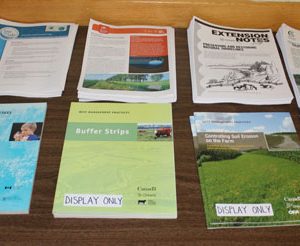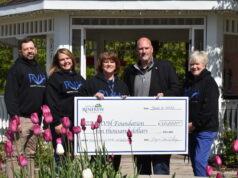Submitted by Barbara Green
MWC Volunteer
COBDEN — About 40 people attended Muskrat Watershed Council’s science session at the Cobden Legion on Saturday, June 25, to hear two guest speakers talk about the importance of clean water and hear suggestions of how to improve water quality in the Muskrat watershed.
The event was organized in partnership with Algonquin College’s Office of Applied Research (Pembroke) as part of the MWC’s Summer Science Sessions, with support from the Great Lakes Guardian Community Fund (GLGCF).
MWC Chair Karen Coulas started off the afternoon by thanking the Great Lakes Guardian Community Fund (GLGCF), a program administered by the Government of Ontario, for funding the event. She also thanked the MWC’s other contributors: Algonquin College, the Ontario Minis-try of Agriculture, Food and Rural Affairs (OMAFRA), SRB Technologies, Jp2g Consultants Inc., the Townships of Whitewater Region, Laurentian Valley, and Admaston/Bromley and all the indi-vidual MWC members who have renewed their memberships.
Michael Michalski ’s presentation
Ms. Coulas introduced guest speaker Michael Michalski, an expert on inland water systems, of Michalski Nielsen Associates. Mr. Michalski is widely respected as one of the top lake scientists in all of Ontario, and has been qualified as an expert witness before the Ontario Municipal Board on numerous occasions.
Mr. Michalski spoke about three topics: limnology, which is the scientific study of fresh water, especially lakes and ponds, and the organisms living there; Ontario freshwater areas where he has worked on restoration and prevention of pollution in fresh water systems; and the importance of creating a framework for improving water quality in Muskrat Lake.
Mr. Michalski spoke about several other regions where techniques for restoration or prevention of pollution, like nutrient loading and blue-green algae, were used. He gave Little Otter Lake in Parry Sound, Ontario, as an example of a successful restoration. This 66-hectare lake was pol-luted from too much phosphorus. There was an industry on the lake that made hubcaps for Ford Thunderbirds. They had a lagoon near the lake to store effluent from the plant. Unfortunately, the berm broke and phosphorus poured into the lake, causing a blue-green algal bloom. Luckily that lake had a high flush rate and within two weeks the lake had flushed out and returned to normal, he said
“If you take the phosphorus away, the lake will improve,” he said. “This was the first example anywhere in the world that (showed) if you take the phosphorus out of the water the lake will im-prove.”
Mr. Michalski spoke about a pollution prevention project on Bigwin Island, in the Lake of Bays area of Muskoka.
“It is a huge resort with elite people,” he said.
Redevelopment of the golf course had the potential to cause pollution problems in the lake, Mr. Michalski explained. The resort proactively built a collector storm water containment area and put in shoreline buffers. There were never any blue-green algal blooms.
Mr. Michalski also gave examples of water quality improvement in the canal system at Holland Marsh, which flows into Lake Simcoe, and in Gravenhurst Bay, which is the headwaters of the Muskoka Lake system.
How does all of this relate to Muskrat Lake? Mr. Michalski said Muskrat Lake is in terrible shape. It has very high levels of phosphorus and substantial depletion of dissolved oxygen in the bottom waters. It has extreme concentrations of phosphorus in the lower depths. There are persistent blooms of blue-green algae and beds of aquatic plant life.
Can Muskrat Lake be fixed? Mr. Michalski said there are ways to remove the phosphorus from the water which could result in improved water quality in a relatively short time.
Alum is one of the treatment options.
“Aluminum sulphate along with iron sulphate are the compounds we would have to look at,” Mr. Michalski said.
The alum binds to the phosphorus in the water and precipitates it to the bottom of the lake.
“The doses of alum or other agents are much lower than what would cause environmental dam-age,” he said. “You would have to treat the lake on multiple occasions.”
But once agricultural runoff is under control you might only have to treat the lake once every 10-15 years, Mr. Michalski added.
He estimated after treatment of the lake for one year you would be able to visually see im-provement. This could be done for a relatively modest cost, possibly only about $5 million. This price and timeline would only be to fix the phosphorus already in the lake. Pollution from agricul-tural runoff, and other potential contributors, might take five to six years to improve.
But before even starting to treat the lake, Mr. Michalski said we will need a framework or plan to identify and evaluate the environmental, social and economic implications of restoration options. Creating the right framework can take time. It took the Holland Marsh project two-and-a-half to three years of working on the plan before they started the cleanup, he said.
And in order to make a plan, you need to get the right people together. An accountable and legal corporation also needs to be established in order to implement the funding required to administer the project.
“You have to get the councils to say, ‘I am not going to take it anymore!’” said Mr. Michalski. “This is what happened in Muskoka. But eastern Ontario is not Muskoka. Without that political will, there’s not much that can be done.”
Only two local political representatives attended Saturday’s session: Charlene Jackson, Council-lor, Township of Whitewater Region and Claus Trost, Volunteer representative, Laurentian Valley Township.
Algonquin Elder, Harold (Skip) Ross’ presentation
Algonquin Elder Harold (Skip) Ross, also spoke at the Muskrat Watershed Council’s June 25 event about his personal connection to local watersheds. Elder Ross introduced himself in his Algonquin-based first language. “My spirit name is running river man,” he said. “I was born on the banks of the Petawawa River and water has always been my concern. I am heavily connected to every form of water – rivers, creeks and lakes.”
Elder Ross spoke about growing up in the Ottawa Valley, learning to be a guide from his father and canoeing on just about every bit of water in the area over his 75 years on the lakes and riv-ers.
“The rivers are so important,” he stressed, adding, “They mean more to us than food, shelter and clothing. Without water you are done.”
That’s why all his life he has fought to protect water quality. He was a member of a group of seven men from Black Bay who protested a recent proposed dam project on the Petawawa River. They were concerned about damage to eels returning to the river to spawn and getting caught in the dam’s turbines. Their efforts were successful and the dam was never built.
For conflict between making money and protecting water, Elder Ross offers the wisdom of an aboriginal prophesy:
“When the last River is poisoned
When the last tree is cut down
When the last fish is caught
You’ll find out that you can’t eat money.”
Since the dam protests, Elder Ross has been involved with the Ottawa Riverkeeper and in 2013 he even helped with a film about the river made by Jacques Cousteau’s granddaughter, Alexan-dra Cousteau. He has also visited 38 schools to talk about Algonquin culture and the importance of rivers and waters.
“Water is so important that in the present and in the past women were the keepers of water,” he said.
“Everything living in this world is connected,” said Elder Ross. “The land, the trees, the sky, the sun and the moon. And all the people. The waters are part of us. Trying to keep the waters pure and clean is a hard job in this world today. We all have to do our bit to keep them clean.”
Muskrat Watershed Council
MWC’s Director of Fundraising, Julie Truelove, spoke about the GLGCF. As part of Ontario’s Great Lakes Strategy it was set up to help communities take action to protect and restore their corner of the Great Lakes, the Ottawa River and connecting channels and watersheds.
Ms. Truelove explained how the MWC and its partners, Algonquin College and OMAFRA, plan to use the GLGCF’s $24,850 grant to protect and improve water quality in the Muskrat watershed.
The MWC will organize four public events between June 2016 and February 2017. These will include two science sessions, one in June and one in the fall of 2016, and two educational events with local schools.
MWC Director of Science, Julie Sylvestre, who also manages applied research projects for the Office of Applied Research at Algonquin College (Pembroke) spoke next. She introduced the three summer co-op students who have been hired under the MWC-Algonquin College partner-ship. Aarika Charlebois, James Wheatley and Martyna Tomczynski will be working in the field on water quality monitoring and controlled tile drainage. They also worked very hard preparing the June 25 workshop, she said.







![Kenopic/Smith Auction [Paid Ad]](https://whitewaternews.ca/wp-content/uploads/2018/10/advertising-100x75.jpeg)

